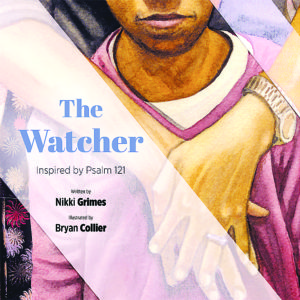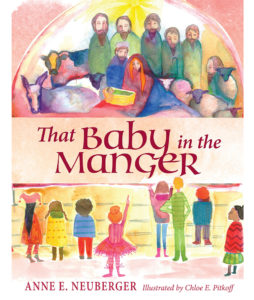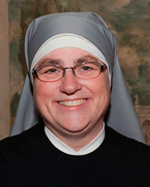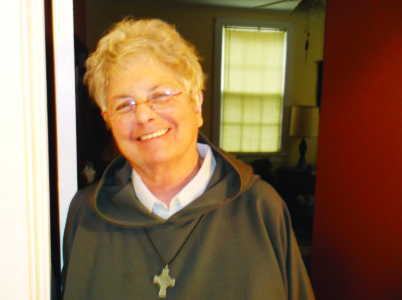By Sean Gallagher
INDIANAPOLIS (CNS) – The theme of the National Catholic Youth Conference (NCYC) in Indianapolis was “Called,” so it was appropriate that the more than 20,000 Catholic youth gathered Nov. 16-18 from across the country gave a bit more attention to the many priests and men and women religious who prayed with them, listened to inspiring presentations with them and had fun with them during the conference.

INDIANAPOLIS, Ind. – Members of McComb St. Alphonsus Parish, (l-r) Ajay Vijayakumar, Jacob Harvey, Gina VanNorman, Adrianna Medina, Emily Mullen, Todd Mullen and Shellie Mullen carry a banner into the opening ceremonies of the National Catholic Youth Conference. (Photo credit to Natalie Hoefer/The Criterion).
Maybe God was using that interaction to call the youth to give prayerful reflection to a religious vocation. “Here we’re able to see their real personalities come out,” said Lillieyne Thompson of the Gary Diocese. “They’re seen more as real people and not just as holy figures. You see how they’re cool and do normal things like everyone else does.
“It helps me realize that I can follow God. You can have a fun life, be yourself without the peer pressure of high school,” she told The Criterion, newspaper of the Archdiocese of Indianapolis. “Seeing how cool all the priests are is so inspiring.”
Six young people from McComb St. Alphonsus Parish made the trip with three parish chaperones. The most common reaction among these teens was excitement to be around so many other Catholics.
“Once I understood how enormous our community was, I understood how powerful it was too. Seeing well- known men and women from across the country share their stories and wisdom, helped me realize that Catholicism is bigger than my home town of McComb or even the convention. Catholicism is truly shown in the community,” said Todd Hoang in an email to Mississippi Catholic. The high school senior said it rejuvenated his faith.
“It was an unforgettable experience. My favorite part was being surrounded by so many Catholics my age who are all longing for that relationship with God. It’s so comforting knowing that the Catholic community is so much larger than what we think it is. We are not alone on this journey. I left Indy thankful for friends, my Catholic faith and the love Jesus has for each and every single one of us,” said Shellie Mullen.
Mullen and Ajay Vijayakumar both reflected on how encouraged they were to see how universal the Catholic faith is. “Although we were from different parts of the country, everyone came together to share our faith. I am so glad that I got a chance to meet other Catholics from the whole nation and join them in song and prayer. It was a spiritually life-changing experience for me,” said Vijayakumar.
The priests and religious present at NCYC also represented more dioceses and religious communities than any of the young participants could know in their homes.
“There’s a lot of not knowing what’s out there,” said Oliver Severance of the Archdiocese of Anchorage, Alaska. “Coming to a place like this, you get to realize that they’re not super far away, stuck in an abbey somewhere. It makes them more accessible. Once you get that realization, it’s easier to go from not knowing what your vocation is to starting to discern and then choose one.”
Salesian Brother Damien Ho of Orange, New Jersey, agreed.
“A lot of young people don’t recognize that they have a vocation or might not even want to know what it is unless they get exposed to different religious groups or missionary groups,” he said. “People here are willing to share about their vocations. The best way to get more vocations is to share about each other’s vocations.
“It’s encouraging, because, as Salesians, we work with young people. So when we see young people see that they have a potential to be better, to become saints, then that’s when our mission gets fulfilled.”
Other religious at NCYC shared the encouragement experienced by Brother Damien.
“Young people today are so open to their faith and seem to have a passion for living it, not only in the Church, but also in service,” said Sister Jean Rhoads, a Daughter of Charity, who lives in Evansville, and serves as a vocations director for her order. “I am hope-filled and encouraged by that. Is this not the most exciting thing in the church today?”
Seminarian Liam Hosty can speak to the effect that NCYC can have on young people trying to hear God’s call in their lives.
He attended two of the conferences while a student at Roncalli High School in Indianapolis. At the time, he was thinking that God might be calling him to the priesthood, but he wasn’t sure about it.
“I told a couple of priests at NCYC that I was thinking about going to seminary,” said Hosty, a sophomore at Bishop Simon Brute College Seminary and Marian University, both in Indianapolis. “I’d say to them, ‘I’m thinking about going to seminary. What do you think?’ Each time, the answer was, ‘Yes. I think you’d be a great fit.'”
He added, “It definitely ramped up my faith. It was absolutely incredible to witness 20,000 youths on fire from all across the country, seeing amazing speakers and having the sacraments available.”
As a seminarian, he participated in his third straight NCYC, but this time as a volunteer, assisting at liturgies and in the room in the Indiana Convention Center where dozens of priests and bishops heard confession.
“It’s life-giving just seeing the young church alive,” Hosty said. “It’s incredible. It’s really cool to be on the other side of the fence trying to help out and kind of give back what all the seminarians and priests gave to me in NCYC.”
(Gallagher is a reporter at The Criterion, newspaper of the Archdiocese of Indianapolis. Wendy Blue, youth minister for St. Alphonsus contributed to this story)







